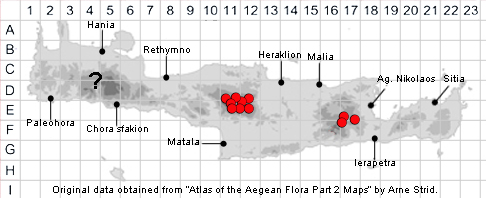
SPECIES DESCRIPTION
POLYGONUM IDAEUM
Family and Genus:- See- POLYGONACEAE/Sect. POLYGONUM
Common Names:- Nida knotgrass
Homotypic Synonyms:- None
Meaning:- Polygonum (Gr) Many joints, a name used by the Greek physician and
botanist Dioscorides, a possible reference to the many nodes.
Idaeum (L) From Mount Ida in Crete.
General description:- Much condensed perennial; stock forming a dense, woody
mat.
Stems:-
1) Flowering, few to several, procumbent, mat forming 1-10 cm, internodes short,
swollen.
Leaves:-
1) First leaf of the branch petiolate, spathulate, the others subsessile, elliptic; 3-12
mm, lower surface pale, with prominent veins, papillose.
2) Ochreae, half as long as the internodes, silvery, ± lacerate.
Flowers:-
1) Solitary in the axils of the leaf-like bracts.
2) Perianth, usually 3-4 mm;
a) segments, connate at the base only, white to pink with a green centre.
Fruit:-
1) Nutlet, 3·5-5 mm, equalling or slightly exceeding the perianth, glossy.
Key features:-
1) Stems, woody at the base. 1-10 cm.
2) Ochreae, in inflorescence longer than the internodes, those in middle part of the
stem usually at least ½ as long as the internodes.
3) Stock, forming a dense, branched, woody mat.
Habitat:- Typical constituent of the vegetation of dolines in the mountains, locally
abundant in Psiloritis. (1100-)1400-2200 m.
Distribution:- Endemic to the Psiloritis and Dikti Massifs.
Flowering time:- June-Aug.
Photos by:- Zacharias Angourakis
